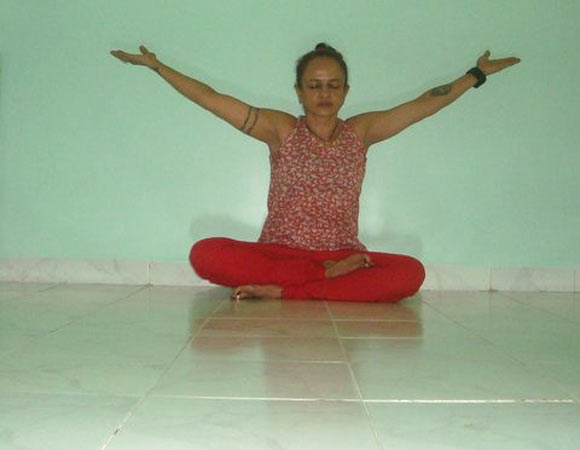 | « Back to article | Print this article |
Chronic shoulder pain? These yoga poses will help
Shameem Akthar, yogacharya trained with the Sivananda Yoga Vedanta Center, takes you through five poses that will sort this problem for you. All of these practices may be attempted any time during the day.
Shoulder pain is a new age epidemic! It is more common amongst those who are not used to strenuous or regular physical activity. It attacks those whose jobs or nature of living requires them to bend forward a lot, as in front of the computers. Interestingly, it also happens due to excessive stress which may jam the upper back considerably. Carrying heavy loads, often on one side of the body also causes this.
However, unlike other parts of the body which may take longer to heal, chronic shoulder pain may be addressed with yoga for instant relief. Even physiotherapy advocated by spine or joint experts involves movements that are very similar to yogic practices. Except in severe pain even conventional medical experts advice movement is best to restore blood circulation back to the troubled joints and help carry repairing elements to them.
Chronic shoulder pain? These yoga poses will help
Druta tadasana (Dynamic palm tree pose)
This may be done standing or seated. Interlock fingers. Lift hands overhead. Turn out palms, so they face the ceiling. Stretch the arms as much as is comfortable. Inhale.
Exhale, drop the arms to the right side, as shown. Keep both hands stretched and straight. Hold. Inhale, return to center. Do for left. This is one round. You may do up to five to 15 rounds each time, several times during the day.
Benefits
Gives a upper body stretch, opening up tension spots along neck and upper back. Tones the shoulder, works the joints. Releases the entire spine and helps manage most spinal problems. Gives a high, by expanding breath capacity. Tones the arms.
A must-do pose for those with a sedentary lifestyle.
Chronic shoulder pain? These yoga poses will help
Parvatasana (Mountain pose)
Sit cross-legged as shown. Place back of the hands on the ground. Inhale, lifting both hands up as slowly as possible, to bring palms together. The slower the inhalation and the simultaneous upward movement of the hands, the better the results.
Exhale slowly beginning to drop the hands back to the ground, as before. Again align the exhalation with the downward descent of the hands, keeping it as slow as your breath will allow.
Do five to ten times.
Benefits
Impacts the whole spine, works out the shoulder muscles and joints powerfully. Tones arms. Impacts breathing powerfully and positively. Calms and de-stresses.
Chronic shoulder pain? These yoga poses will help
Prishtasana (Lizard pose)
Sit on your fours. Inhale. Exhaling, push the hips back as shown, lowering the chin or the forehead to the ground, between the hands, which are stretched on the ground, as shown. Hold the pose. Dropping the chin extends the upper back, while dropping the forehead helps relax it. The former may be difficult for those with shoulder pain, and must be attempted only in the resolving/healing phase.
Benefits
Controls upper back problems. Works the shoulders. Extends the chin, working on the thyroid and parathyroid.
Pushes into the thymus (immune gland), massaging it, positively impacting immunity. Releases stiffness along the entire spine. Is very soothing and relaxing to the mind.
Chronic shoulder pain? These yoga poses will help
Tadasana (Palmtree stretch)
Maybe done standing or seated. Interlock fingers behind your torso. Push the palms out. Inhale. Gently lift the arms up, as shown, only as much as is possible.
Exhale, relax arms back to the starting point. This is one round. Do up to five or ten. This is an intense stretch and requires some shoulder rolls as warm-up.
Benefits: Same as listed for Prishtasana.
Chronic shoulder pain? These yoga poses will help
Marjariasana (Cat stretch)
May be done seated or standing. Interlock fingers, pushing palms outwards. Inhale raise the arms up, as shown. Push the stomach in, stretching the arms as much as is possible.
Hold the breath (if not having circulatory, blood pressure, respiratory or heart problems) for five seconds. Release to return arms back to starting point. Do five times or so.
Benefits
Releases pain along shoulders, encourages blood flow to the area. Tones the stomach. Boosts mood. Works the entire spine.





